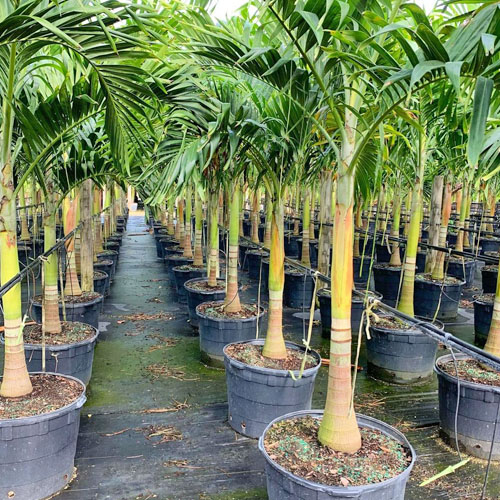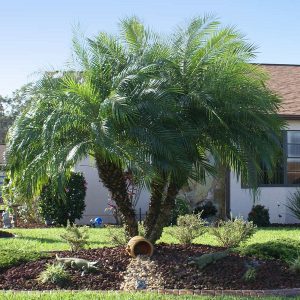The Christmas palm, also known as Adonidia merrillii, is a stunning ornamental tree perfect for residential landscaping. This evergreen medium-sized tree reaches up to 25 feet tall, making it ideal for those who want to create a tropical atmosphere in their backyard but don’t have a lot of space.
What is a Christmas palm?
The Christmas palm, also referred to as the Manila palm or dwarf Royal, is a charming addition to any warm-season garden. Native to the Philippines, this tropical tree is perfectly suited for United States Department of Agriculture zone 10. The tree’s modest stature, growing only 20 to 25 feet (6-8 m.) in height, makes it an ideal choice for homeowners who want a smaller palm that doesn’t require a lot of upkeep. One of the tree’s most attractive features is that it is self-cleaning, eliminating the need for excessive pruning or maintenance. If you’re a fortunate gardener living in a warm climate, consider adding the Christmas palm to your landscape for an effortlessly stylish and tropical touch.
- Scientific name: Adonidia merrillii
- Common names: The Christmas Palm is also known as Manila Palm, Kerpis Palm, Adonidia Palm, Dwarf Royal Palm, and Veitchia Palm.
- Family: Arecaceae.
- Origin: It is native to the small islands of the Philippines located north of Malaysia and Indonesia.
- Appearance: The Christmas Palm has a smooth slender grey trunk that is slightly swollen at the base and ringed with old leaf scars. The Christmas Palm may be used alone or may also be planted in groups of two or three.
- Bright green crownshaft supports a crown of 10-12 pinnate, or feather-shaped, fronds. The short crownshaft is about 3ft long. Leaves are glossy, strongly arched, grow to a length of 5 feet with sharp-edged leaflets that are up to 2 feet long by 2 inches wide.
- Flowers/Fruits: During the summer months the Christmas Palm produces light green flower buds that turn into creamy blossoms. Unisexual flowers are held by 2ft long branched stalks that emerge from the area where the crownshaft attaches to the trunk. In December flowers are followed by green oval fruits that turn bright red as they are ripe. Berrie-like fruits are 1 inch long and 1/5 inch wide. They hang in clusters looking like Christmas ornaments, therefore palm’s common name is Christmas Palm.
- Growth Rate: Moderate to Fast. In the wild Veitchia merrillii is known to grow up to 25ft tall but in cultivation, it usually doesn’t get taller than 10 – 20 ft and 5-10 ft wide.
- Outdoor/Indoor Use: Both.
The Christmas palm is a fascinating tree that has much to offer to home landscapers. This species, also known as the Manila palm or dwarf Royal, hails from the Philippines and is a delightful addition to warm climate gardens. This palm is well-suited to the United States Department of Agriculture zone 10, where it thrives and adds tropical flair to landscapes.
The Christmas palm is a rapid grower that can quickly reach six feet in height, making a dramatic statement in any setting. However, once the tree has established itself, the growth rate slows down considerably, allowing gardeners to easily maintain its size. The trunk of this palm is smooth and ridged and can grow up to 5-6 inches in diameter, while the tree’s elegantly bowed crown may spread out to 8 feet.
One of the most striking features of the Christmas palm is its arching pinnate leaves, which can grow up to 5 feet in length. But, what is most interesting about this palm is how it got its name. The plant produces bright red clusters of fruits that ripen around the same time as the Advent season. Although some gardeners find the fruits to be a nuisance, removing them before ripening usually solves any messy issues.
Overall, the Christmas palm is a beautiful, low-maintenance tree that can add tropical flair to any home landscape. Its rapid growth and unique characteristics make it an excellent choice for gardeners seeking a statement tree that will make a lasting impression.
How to Grow a Christmas Palm Tree
When it comes to planting Christmas palm trees, landscape designers often prefer to plant them in close proximity to one another, creating a stunning grove with their small root balls. However, it’s important to note that planting too closely together can result in some trees struggling to thrive due to increased competition for resources.
Another crucial factor in the successful growth of Christmas palm trees is providing them with adequate lighting. Insufficient light can lead to thin and spindly trunks, as well as sparse foliage.
For those interested in cultivating their own Christmas palm trees, the process begins by collecting the seeds when they are ripe in late fall to early winter. After cleaning off the pulp, the seeds should be soaked in a 10% bleach and water solution. Plant the seeds in flats or small containers, planting them shallowly, and place them in an environment with temperatures ranging from 70 to 100 degrees Fahrenheit (21 to 37 C.). It’s important to keep the container consistently moist. Fortunately, the germination process for Christmas palm seeds is quite rapid, and one should expect to see sprouts emerging in as little as a few weeks.
Christmas Palm Tree Care
The Christmas palm is a low maintenance tree that is well suited for warm climates. It thrives in well-drained, slightly sandy soil that is exposed to full sun, although it can also tolerate some light shade. While establishing, the tree requires supplemental water, but once it reaches maturity, it can tolerate short periods of drought. Additionally, the tree is quite resilient and tolerant of saline soils. For optimal growth, fertilize every four months with a time release palm food.
One of the great benefits of this tree is that it is self-cleaning, so pruning is not typically required. However, it is important to note that the Christmas palm is susceptible to Lethal Yellowing disease, which can eventually take down the palm. Fortunately, there is a preventative inoculation that can be administered before the plant contracts the disease. While there are a few fungal diseases to be aware of, Christmas palm tree care is generally a breeze, which is why this plant is so popular in warm climates.






